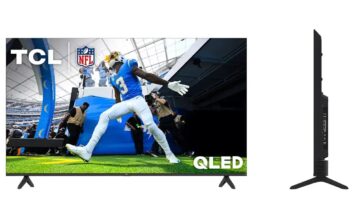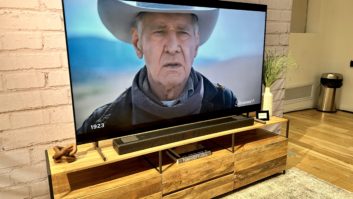SAN DIEGO – Industry reaction to the recently announced restructuring of Sony Electronics involving the sale of most of the Vaio PC business and the split-off of its TV operations into a wholly owned subsidiary was viewed with mixed reactions by analysts and retailers.
Most observers said the moves should help to keep Sony profitable while enabling the TV operations to narrow its focus on the woefully underserved high-end segment of the TV market, where profits can be made.
In its recent fiscal third-quarter financial statement, Sony said it was selling all but 5 percent of its shrinking Vaio PC business in Japan to Japan Industrial Partners (JIP), and will revamp its hemorrhaging TV business unit in order to focus on high-end models in the United States while spinning it off as a wholly owned subsidiary.
Sony also said that 5,000 jobs will be cut as part of the changes.
Paul Gagnon, NPD DisplaySearch North American TV research director, said, “Viewing this as good or bad depends on the point of view. If the decision to spin off an unprofitable group helps improve the financial standing of the parent company, then it could be viewed as a good decision. If the spin-off leads to continued poor performance by the resulting entity, with more visible disclosure of the finances, then it might prove challenging for Sony to move to the next step, which might include trying to sell the assets like they did with Vaio.”
Gagnon said Sony’s “hint” at its new go-to-market strategy involving a high-end/low-end approach for developed and emerging markets, respectively, “isn’t much different than the current approach.”
He pointed out that “a high-end niche strategy will result in significantly lower market share, but perhaps that’s OK if it is a profitable business. Pioneer’s exit a few years ago shows that this is not an easy strategy, particularly if there are volume requirements to keeping baseline costs competitive.”
Jill Turic, Quixel Research managing director and senior analyst, said, “It’s not sayonara for Sony TV – if managed correctly, this could be Sony’s opportunity to focus on making a high-end TV, or 4K-weighted strategy, work. There is plenty of life left in the Sony brand – it is still meaningful for older, higher-end consumers and also younger consumers, especially considering PlayStation 4’s highly successful Q4 launch.”
Although 2013 “was just a positioning year for 4K,” Turic said, “Sony was first out of the gate with a strong consolidated message across the 4K ecosystem and led the market. The big question is do they have the wherewithal to be a lower volume, high-end TV player and all the discipline that goes with it? Potentially a bigger question is do retailers believe Sony management can reignite the Sony magic with 4K once the market really heats up? Samsung has a very strong 4K lineup and is not going to sit back in 2014.”
Turic added that Quixel is projecting close to 1 million 4K Ultra HD unit shipments in the U.S. for 2014 and triple that in 2015, “so the price game will very rapidly move to the 4K segment, and it is hard to play the price game with lower volume,” she said.
At least one retailer applauded Sony’s decision to narrow its focus on the high-end of the TV and market.
Robert Zohn, proprietor of Scarsdale, N.Y.-based A/V specialty retailer Value Electronics, said, “Sony’s return to its core specialty as one of the leaders in advanced display technology is the most welcome and encouraging news of 2014.”
“Sony’s timing could not be better as video-enthusiasts are still in mourning over Pioneer’s 2009 and now Panasonic’s 2014 exit from PDP,” Zohn continued. “Even Sharp’s exceptional Elite full-array LED displays are gone. This has left a vacuum that is so well matched for Sony to fill. The task at hand is about filling all of the happy videophiles’ homes and Sony is taking the straight and narrow road to their hearts with fairly priced 65- and 85-inch highperformance full-array LED panels.”
“With all this said, I don’t think it’s a cake walk for Sony as Panasonic, Samsung and LG’s second-gen LED TVs – and possibly even more importantly LG’s 4K 55-, 65- and 77-inch OLED TVs – all look promising for the video enthusiast market.”
Meanwhile, Sony’s decision to sell most of its interests in the Vaio business was received less favorably by Stephen Baker, NPD Group industry analysis VP.
“Sony’s problems (to the extent there really were problems) are more self-made than a function of the industry troubles,” Baker wrote, adding the company “had trouble balancing the need for volume and scale with their ability to lead the market in design and appearance,” resulting in “constant back-and-forth movement between a focus on the premium segment and then sometimes a focus on the basic volume segment. As a company, they were never willing to commit to winning in both segments at the same time.”
“The result was a brand that was always facing limited shelf space, lack of presence in key market segments, and an inconsistent approach that confused customers and retailers and didn’t use [its] considerable brand strength to its advantage. In many ways this mirrors the long-term challenges Sony has faced in their TV business,” Baker continued. “We find this decision to be particularly troubling, and one that is likely, ultimately, at least in the U.S. to be decidedly unsuccessful.”
“Shifting focus onto tablets and smartphones is all well and good, however, the synergy; in distribution, in design and in branding between those segments is undeniable (especially here in the U.S. and among the higher value products Sony favors). And Sony’s total lack of success here in the U.S. in those segments is not likely to improve without a PC business alongside,” he concluded.
DisplaySearch’s Gagnon added, “The sale of the Vaio business shows that there may no longer be any sacred cows at Sony, and there are likely plenty of eager companies looking to leverage a strong existing brand to make a large step in growth.”













